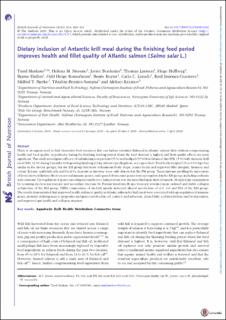| dc.contributor.author | Mørkøre, Turid | |
| dc.contributor.author | Moreno, Helena Maria | |
| dc.contributor.author | Borderías, Javier | |
| dc.contributor.author | Larsson, Thomas | |
| dc.contributor.author | Hellberg, Hege | |
| dc.contributor.author | Hatlen, Bjarne | |
| dc.contributor.author | Romarheim, Odd Helge | |
| dc.contributor.author | Ruyter, Bente | |
| dc.contributor.author | Lazado, Carlo C. | |
| dc.contributor.author | Jimenez Guerrero, Raul | |
| dc.contributor.author | Bjerke, Målfrid Tofteberg | |
| dc.contributor.author | Benitez-Santana, Tibiabin | |
| dc.contributor.author | Krasnov, Aleksei | |
| dc.date.accessioned | 2020-11-16T14:23:14Z | |
| dc.date.available | 2020-11-16T14:23:14Z | |
| dc.date.created | 2020-07-27T10:36:24Z | |
| dc.date.issued | 2020 | |
| dc.identifier.citation | British Journal of Nutrition. 2020, 124(4), 418-431. | en_US |
| dc.identifier.issn | 0007-1145 | |
| dc.identifier.uri | https://hdl.handle.net/11250/2688077 | |
| dc.description.abstract | There is an urgent need to find alternative feed resources that can further substitute fishmeal in Atlantic salmon diets without compromising health and food quality, in particular during the finishing feeding period when the feed demand is highest and flesh quality effects are most significant. This study investigates efficacy of substituting a isoprotein (35 %) and isolipid (35 %) low fishmeal diet (FM, 15 %) with Antarctic krill meal (KM, 12 %) during 3 months with growing finishing 2·3 kg salmon (quadruplicate sea cages/diet). Final body weight (3·9 (se 0·04) kg) was similar in the dietary groups, but the KM group had more voluminous body shape, leaner hearts and improved fillet integrity, firmness and colour. Ectopic epithelial cells and focal Ca deposits in intestine were only detected in the FM group. Transcriptome profiling by microarray of livers showed dietary effects on several immune genes, and a panel of structural genes were up-regulated in the KM group, including cadherin and connexin. Up-regulation of genes encoding myosin heavy chain proteins was the main finding in skeletal muscle. Morphology examination by scanning electron microscopy and secondary structure by Fourier transform IR spectroscopy revealed more ordered and stable collagen architecture of the KM group. NEFA composition of skeletal muscle indicated altered metabolism of n-3, n-6 and SFA of the KM group. The results demonstrated that improved health and meat quality in Atlantic salmon fed krill meal were associated with up-regulation of immune genes, proteins defining muscle properties and genes involved in cell contacts and adhesion, altered fatty acid metabolism and fat deposition, and improved gut health and collagen structure. | en_US |
| dc.language.iso | eng | en_US |
| dc.rights | Attribution-NonCommercial-NoDerivatives 4.0 Internasjonal | * |
| dc.rights.uri | http://creativecommons.org/licenses/by-nc-nd/4.0/deed.no | * |
| dc.title | Dietary inclusion of Antarctic krill meal during the finishing feed period improves health and fillet quality of Atlantic salmon (Salmo salar L.) | en_US |
| dc.type | Peer reviewed | en_US |
| dc.type | Journal article | en_US |
| dc.description.version | publishedVersion | en_US |
| dc.source.pagenumber | 418-431 | en_US |
| dc.source.volume | 124 | en_US |
| dc.source.journal | British Journal of Nutrition | en_US |
| dc.source.issue | 4 | en_US |
| dc.identifier.doi | 10.1017/S0007114520001282 | |
| dc.identifier.cristin | 1820564 | |
| cristin.ispublished | true | |
| cristin.fulltext | original | |
| cristin.qualitycode | 1 | |

